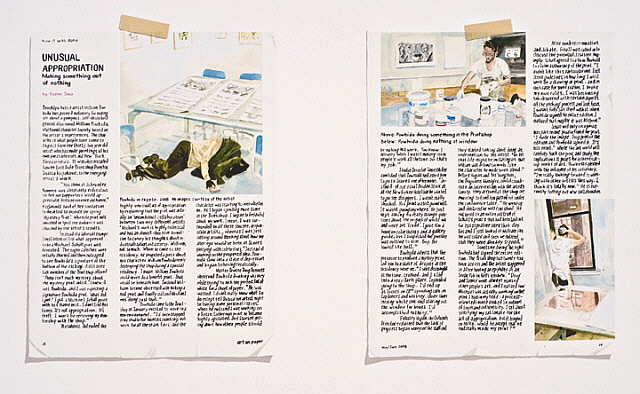
William Powhida, "Unconscious Collaboration (number 1)," 2008, edition of 75. Screenprint and digital inkjet with collage, image: 11 1/2 x 19 3/4 in., sheet: 22 x 30 in. Courtesy Lower East Side Printshop, New York.
The contemporary art fair Art Basel Miami Beach takes place this week, bringing with it a flurry of activity. In the spirit of participation, Ink is dedicated this month to the prints of William Powhida, a Brooklyn-based artist whose work lays bare the inner workings of the contemporary art world (in fact, his current project is taking place in Miami, see below). A reluctant yet active insider, he offers his frank, unadorned view of the contemporary art world’s mostly uncharted territory. His text-based work is peppered with strong terms, ribald satire, and ironic self-aggrandizement (his Tumblr blog page is titled G-E-N-I-U-S). In an interview with the artist, when speaking of his work, Powhida describes two distinct strands – the “overtly comedic [that is] topical in the sense that it is reactive to what is going on” and the “imaginary universe where anything can be made to happen.” He is simultaneously celebrated and reviled by the art world players he exposes, and his work can precipitate a formidable storm under the right conditions.
In addition to working in traditional art-object formats (drawing, painting, prints), Powhida maintains a strong presence in cyberspace. He has the requisite artist’s website, but he is also a veteran blogger, tumblr-er, tweeter, and commentator. In addition, he frequently participates in and organizes public discussions and events. Earlier this year Powhida collaborated with Jennifer Dalton on a month-long series of events and discussions at Winkleman Gallery that were open to all. The project, titled #Class, was designed to question the systems and hierarchies that attach monetary value to art. Events were documented in real time with twitter feeds, blog posts, and live streaming video. The two pair up again this week with a similar project titled #Rank to probe the hierarchies that dictate one’s place in the culture of the contemporary art fair, coinciding with Art Basel Miami Beach. #Rank takes place through December 4 at Seven, a nearby venue, and will be documented in real time on the project website.
Powhida’s two-dimensional works are primarily text-heavy drawings in the form of lists, satirical faux-articles and editorials, or caricatures of the art-world figures he skewers, surrounded by commentary. He has produced a handful of original prints in the same vein. His first – Lower East Side Printshop’s 2008 mystery benefit edition titled Unconscious Collaboration (number 1)–was parody of an article from the defunct magazine Art on Paper, titled Unusual Appropriation: Making Something Out of Nothing. The opening line reads, “Brooklyn based [sic] artist William Powhida has gained notoriety for making art about a pompous, self-absorbed genius also named William Powhida, a fictional character loosely based on the artist’s experiences.” The text goes on to describe an imagined series of events surrounding Powhida’s process of creating the mystery print edition in which he is overwhelmed by the task, frequently leaves the studio to frequent bars and strip clubs, and eventually fails to deliver an original print, instead signing the work of another artist. The illustrations for the article show Powhida in various states of inaction at LESP with appropriate captions – “Powhida in repose” (passed out on the floor), “doing something in the Printshop” (dabbling with inks), and “doing something at the window” (gazing outside, hand on his head).
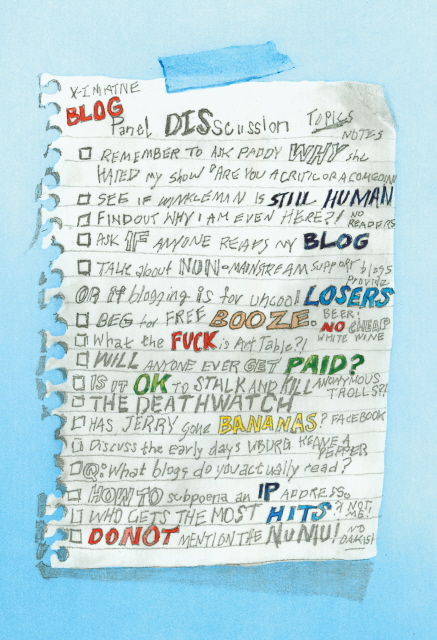
William Powhida, "Panel Discussion," 2010. Edition of 16, soft ground etching and aquatint with watercolor hand additions, plate: 11 3/4 x 8 3/4 in., sheet: 20 x 16 in. Courtesy Lower East Side Printshop, New York.
Powhida was invited to work at the LESP again earlier this year for a Publishing Residency, during which he created two individual prints and a suite of screenprints. Panel Discussion combines the artist’s digital and analog modes of working. This hand-colored softground etching was prompted by a heated, real-time panel discussion about art blogging that included Powhida, Paddy Johnson (the author of Art Fag City), Edward Winkleman, a gallerist who blogs, and Kelly Shindler, editor of this blog. In this piece, Powhida – who dropped his self-promoting eponymous alter ego after actually becoming somewhat famous in 2009 – stages a personal rant on an illusionistic sheet of notebook paper covered in his distinctive scrawl, then posted to a blank wall as if it were a poster one might encounter in a public space. As is common in Powhida’s work, there are several references to art world personalities and entities – specifically, the aforementioned bloggers and the prominent critic Jerry Saltz. The final checkbox on the list (“DO NOT MENTION THE NUMU! NO DAKIS!”) refers to the controversy surrounding his cover for the November 2009 issue of The Brooklyn Rail – titled How The New Museum Committed Suicide with Banality, in which Powhida lambasts the museum for showing the collection of trustee Dakis Joannou. Powhida discusses these issues in his guest blog post on this site.
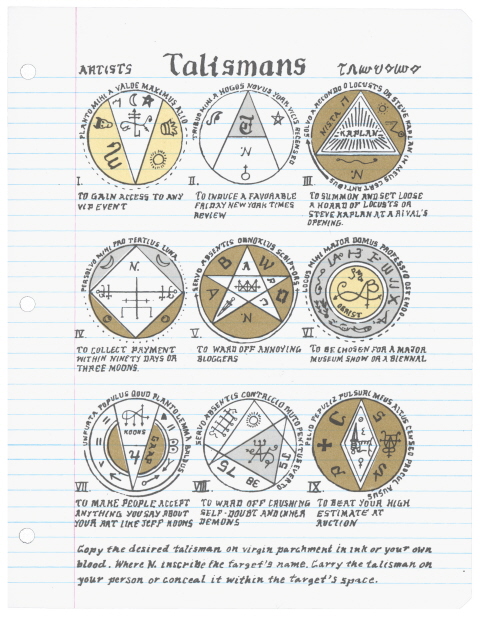
William Powhida, Plate 6 of 13 from "Ars Magica," 2010. Edition of 13, screenprint, image and sheet: 11 x 8 1/2 in. Courtesy Lower East Side Printshop, New York.
In the suite Ars Magica, Powhida imagines placing mastery in the hands of artists, who usually have little or no control over how their work is received and commodified. The portfolio of 13 prints resembling doodles on notepad paper is housed in an archival manila envelope with a symbol on the cover resembling that of a secret society. The casual presentation, which imitates everyday office or school supplies, gives pause for thought: is this a means of camouflaging the powerful information within or are these the delusional scribblings of a frustrated, imaginary artist? Or both? The contents ostensibly provide insight and access into the insular art world for the purpose of conjuring spells to overcome traditional power structures and the whims of the art market. One sheet contains talismans for various desired outcomes: “To gain access to any VIP event” or “To induce a favorable New York Times review.” Another contains cryptic charms representing a handful of the most powerful figures in the contemporary art world; one represents artist Jeff Koons, who holds the title “Prince of the East,” while another stands for MoMA director Glenn Lowry, who is “Grand Duke of the East.”
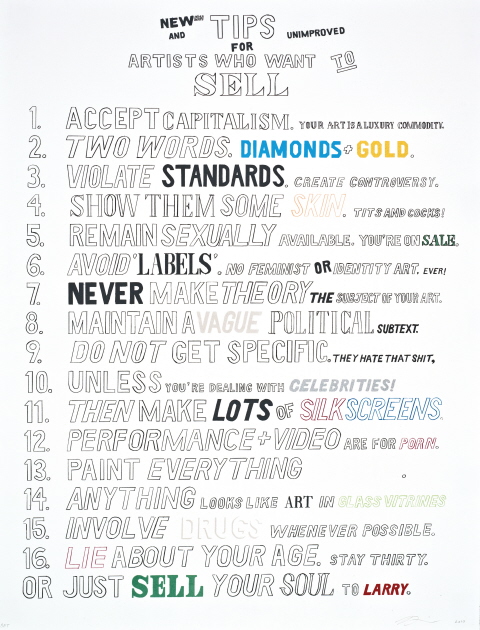
William Powhida, "Tips for Artists Who Want to Sell (new and unimproved)," 2010. Edition of 30, screenprint, image and sheet: 30 1/4 x 23 in. Courtesy Lower East Side Printshop, New York.
In a similar vein, Powhida provides a laundry list of helpful pointers for his colleagues in the screenprint Tips for Artists Who Want to Sell (new and unimproved) – an update of the famous 1966-68 painting by John Baldessari (currently on view through January 9 in the retrospective exhibition John Baldessari: Pure Beauty at the Metropolitan Museum of Art and featured on its website; Ink‘s January post will be dedicated to Baldessari’s prints). Baldessari’s tongue-in-cheek advice (“Generally speaking, paintings with light colors sell more quickly than paintings with dark colors.”), though still relevant, comes across as somewhat limited and proper in today’s environment of open sexuality, multimedia artworks, and mega-art-star culture. In re-imagining the subject, Powhida expands upon Baldessari’s guidance with such pointers as “Remain sexually available. You’re on sale.” and “Make lots of silkscreens.” Ironically, the work itself is a silkscreen and – like Baldessari’s painting, which was executed by a professional sign painter – Powhida’s piece is not, strictly speaking, an original, but rather a reworking of a drawing. On a more serious level, Powhida chose screenprinting because he felt the process of translating the drawing to a screen refined and improved the quality of the lettering, resulting in a polished but flawed effect that is similar to the sign painter’s hand in Baldessari’s work.
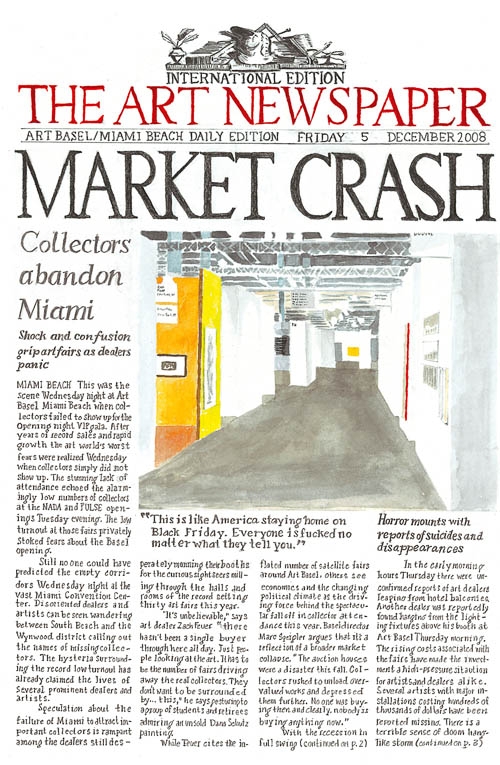
William Powhida, "Market Crash," 2007. Edition of 50, archival digital print, sheet: 31 x 24 in. Published by Schroeder Romero, New York, and Platform Gallery, Seattle. Image courtesy Schroeder Romero, New York.
Powhida has also produced a handful of archival digital inkjet prints that replicate his drawings; these types of editions are categorized in the world of printmaking as artist-endorsed reproductions – a distinction that is likely moot for the artist (and many readers) but should be made nonetheless. The first was Market Crash (2007), a spoof on an Art Newspaper article that foretold the demise of the art market bubble well in advance of the fact. He later created an edition for the website 20×200 of his drawing Why You Should Buy Art. Editions also exist for the drawings How The New Museum Committed Suicide with Banality, and Hooverville, a collaborative work with Jade Townsend that was first shown at the 2009 Pulse Art Fair, a satellite to Art Basel Miami Beach. Both drawings generated online brawls summarized in William Powhida is Making Fun of Me, and I Love It, a review by Jerry Saltz published in New York magazine last March.
The greatest irony of all is that Powhida’s outrageous approach to gaining fame in the art world – by self-declaration – has actually worked, thus seemingly proving his point that it is all smoke and mirrors. In fact, Powhida is a talented, intelligent, and surprisingly modest artist or this would not be his story. In addition, the art world is in sore need of correction and his biting satire provides much-needed comic relief and perspective, hopefully toward a healthier future. As revealed by Powhida’s and Dalton’s #Class project, the art world is unlikely to become a place where everyone feels included and meritocracy reigns, but until it does, we can count on William Powhida to be the whistleblower.
Parts of this article were previously published in the author’s essay for Editions ‘10 (New York: Lower East Side Printshop, 2010).



Pingback: What To Do, What To Do | Art21 Blog
Pingback: What To Do, What To Do | Uber Patrol - The Definitive Cool Guide